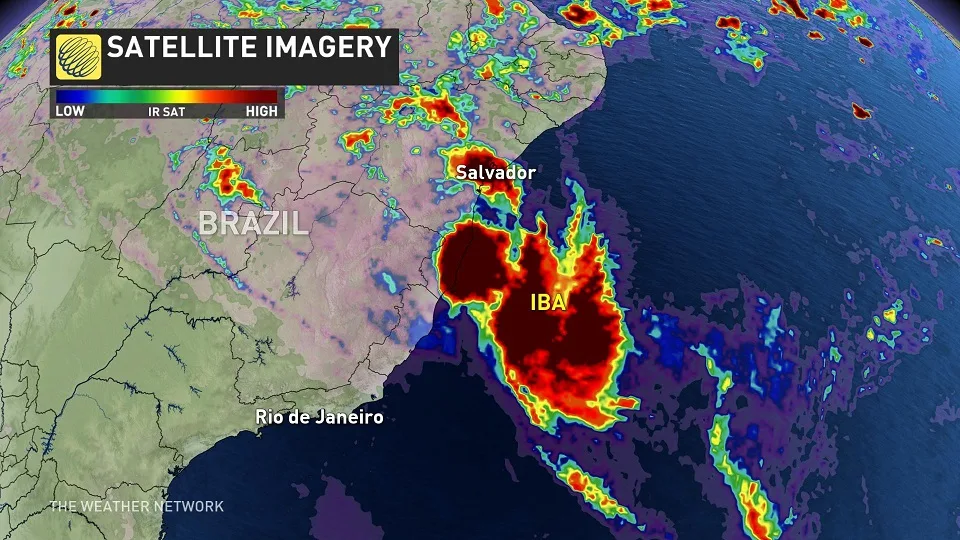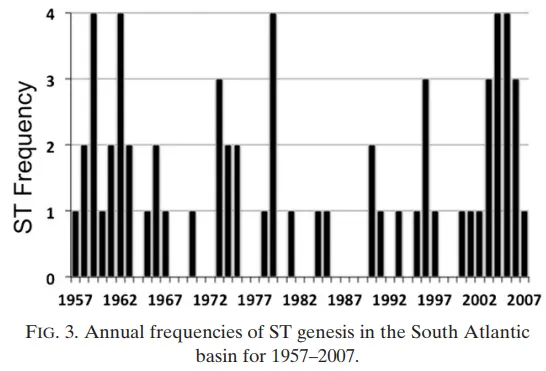
Tropical anomaly Storm Iba swirls off Brazilian coast
A rare South Atlantic tropical storm -- the first to form in that ocean since 2010 -- continues to swirl off the coast of Brazil, bringing strong winds and rough seas.
As of Monday morning, the storm boasted maximum gusts of 87 km/h, stronger than the previous day, as it churned the seas off the coasts of the Brazilian states of Bahia and Espirito Santo. It is not expected to reach hurricane strength, but Brazil's National Institute of Meteorology (INMET) says the storm will generate winds of 61 km/h along the coasts, along with 3-5 metre waves at sea and 2.5 metres through the coasts.
WATCH BELOW: STORM IBA'S EXPECTED PROGRESS
A RARE EVENT
While tropical cyclones are well-known in the rest of the planet's ocean basins, the South Atlantic is the exception. In fact, it's only in the last 15 years or so that researchers came to understand tropical storms formed there at all.
A very particular environment is required for tropical systems to form, with the list of needed ingredients including warm surface water below, and a lack of wind shear (winds changing speed/direction with height) above. While the South Atlantic frequently makes the grade as far as sea surface temperatures go, wind shear is generally too high to make for an inviting breeding ground for tropical storms.
It was March 2004's Hurricane Catarina, which made landfall in Brazil with the strength of a Category 1 storm, that forced forecasters and researchers to reconsider their views on the 'quiet South Atlantic,' and the results were eye-opening.
Hurricane Catarina began life as a subtropical cyclone and went on to intensify into the full-fledged tropical cyclone on record for the South Atlantic, leading researchers, forecasters, and emergency managers alike to wonder if another such storm was possible. A study released in the Journal of Climate in 2012 revealed 63 subtropical cyclones had formed in the South Atlantic between 1957 and 2007 (the period examined by researchers), meaning that about one subtropical system forms in the region every year.

Image courtesy Journal of Climate/Evans and Braun
"North Atlantic [subtropical storms] (ST) have been shown to undergo tropical transition to [tropical cyclones] (TC) (Davis and Bosart 2003, 2004) with relative regularity (Guishard et al. 2009)," reads the study. "Thus, a climatology of STs has the potential to provide insights on the dearth of South Atlantic TCs, as well as on the STs themselves."
Given the lack of data, it's hard to say whether the subtropical-to-tropical storm transition is becoming more likely in the South Atlantic, but it is something forecasters are keeping an eye on, and an avenue for future research.
"Until the evolution of Hurricane Catarina (2004) from a ST, a TC had not been observed in the South Atlantic, but now that this pathway from ST to TC has been documented, the potential for further TC developments in the South Atlantic has been raised," add Evans and Braun in the study. "Possible impacts of climate change on subtropical, and even tropical, cyclogenesis in the South Atlantic remain an open question."
Sources: BNHC | Weather Underground | Journal of Climate | INMET










